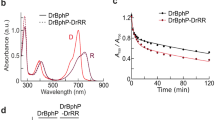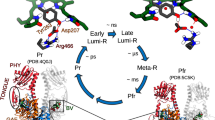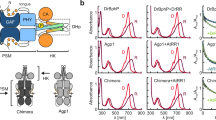Abstract
Phytochromes are bimodal photoswitches composed of a photosensor and an output module. Photoactivation of the sensor is initiated by a double bond isomerization of the tetrapyrrole chromophore and eventually leads to protein conformational changes. Recently determined structural models of phytochromes identify differences between the inactive and the signalling state but do not reveal the mechanism of photosensor activation or deactivation. Here, we report a vibrational spectroscopic study on bathy phytochromes that demonstrates that the formation of the photoactivated state and thus (de)activation of the output module is based on proton translocations in the chromophore pocket coupling chromophore and protein structural changes. These proton transfer steps, involving the tetrapyrrole and a nearby histidine, also enable thermal back-isomerization of the chromophore via keto–enol tautomerization to afford the initial dark state. Thus, the same proton re-arrangements inducing the (de)activation of the output module simultaneously initiate the reversal of this process, corresponding to a negative feedback mechanism.
This is a preview of subscription content, access via your institution
Access options
Subscribe to this journal
Receive 12 print issues and online access
$259.00 per year
only $21.58 per issue
Buy this article
- Purchase on Springer Link
- Instant access to full article PDF
Prices may be subject to local taxes which are calculated during checkout






Similar content being viewed by others
References
Briggs, W. R. & Spudich, J. L. Handbook of Photosensory Receptors (Wiley, 2005).
Rockwell, N., Su, Y. & Lagarias, J. C. Phytochrome structure and signaling mechanisms. Annu. Rev. Plant Biol. 57, 837–858 (2006).
Rockwell, N. C. & Lagarias, J. C. A brief history of phytochromes. ChemPhysChem 11, 1172–1180 (2010).
Karniol, B. & Vierstra, R. D. The pair of bacteriophytochromes from Agrobacterium tumefaciens are histidine kinases with opposing photobiological properties. Proc. Natl Acad. Sci. USA 100, 2807–2812 (2003).
Wagner, J. R., Brunzelle, J. S., Forest, K. T. & Vierstra, R. D. A light-sensing knot revealed by the structure of the chromophore-binding domain of phytochrome. Nature 438, 325–331 (2005).
Wagner, J. R., Zhang, J. R., Brunzelle, J. S., Vierstra, R. D. & Forest, K. T. High resolution structure of Deinococcus bacteriophytochrome yields new insights into phytochrome architecture and evolution. J. Biol. Chem. 282, 12298–12309 (2007).
Yang, X., Stojkovic, E. A., Kuk, J. & Moffatt, K. Crystal structure of the chromophore binding domain of an unusual bacteriophytochrome, RpBphP3, reveals residues that modulate photoconversion. Proc. Natl Acad. Sci. USA 104, 12571–12576 (2007).
Essen, L. O., Hughes, J. & Mailliet, J. The structure of a complete phytochrome sensory module in the Pr ground state. Proc. Natl Acad. Sci. USA 105, 14709–14714 (2008).
Bellini, D. & Papiz, M. Z. Dimerization properties of the RpBphP2 chromophore-binding domain crystallized by homologue-directed mutagenesis. Acta Crystallogr. D 68, 1058–1066 (2012).
Yang, X. J., Kuk, J. & Moffat, K. Crystal structure of Pseudomonas aeruginosa bacteriophyrochrome: photoconversion and signal transduction. Proc. Natl Acad. Sci. USA 105, 14715–14720 (2008).
Yang, X. J., Kuk, J. & Moffat, K. Conformational differences between the Pfr and Pr states in Pseudomonas aeruginosa bacteriophytochrome. Proc. Natl Acad. Sci. USA 106, 15639–15644 (2009).
Yang, X. J., Ren, Z., Kuk, J. & Moffat, K. Temperature-scan cryocrystallography reveals reaction intermediates in bacteriophytochrome. Nature 479, 428–432 (2011).
Takala, H. et al. Signal amplification and transduction in phytochrome photosensors. Nature 509, 245–248 (2014).
Anders, K., Daminelli-Widany, G., Mroginski, M. A., von Stetten, D. & Essen, L. O. Structure of the cyanobacterial phytochrome 2 photosensor implies a tryptophan switch for phytochrome signaling. J. Biol. Chem. 288, 35714–35725 (2013).
Lamparter, T., Michael, N., Mittmann, F. & Esteban, B. Phytochrome from Agrobacterium tumefaciens has unusual spectral properties and reveals an N-terminal chromophore attachment site. Proc. Natl Acad. Sci. USA 99, 11628–11633 (2002).
Inomata, K. et al. Assembly of synthetic locked chromophores with Agrobacterium phytochromes AGP1 and AGP2. J. Biol. Chem. 281, 28162–28173 (2006).
Rottwinkel, G., Oberpichler, I. & Lamparter, T. Bathy phytochromes in rhizobial soil bacteria. J. Bacteriol. 192, 5124–5133 (2010).
Zienicke, B. et al. Unusual spectral properties of bacteriophytochrome Agp2 result from a deprotonation of the chromophore in the red-absorbing form Pr. J. Biol. Chem. 44, 31738–33175 (2013).
Salewski, J. et al. The structure of the biliverdin cofactor in the Pfr state of bathy and prototypical phytochromes. J. Biol. Chem. 288, 16800–16814 (2013).
Scheerer, P. et al. Light-induced conformational changes of the chromophore and the protein in phytochromes: bacterial phytochromes as model systems. ChemPhysChem 26, 1090–1105 (2010).
Tasler, R., Moises, T. & Frankenberg-Dinkel, N. Biochemical and spectroscopic characterization of the bacterial phytochrome of Pseudomonas aeruginosa. FEBS J. 272, 1927–1936 (2005).
Mroginski, M. A. et al. Elucidating photoinduced structural changes in phytochromes by the combined application of resonance Raman spectroscopy and theoretical methods. J. Mol. Struct. 993, 15–25 (2011).
Fodor, S. P. A., Lagarias, J. C. & Mathies, R. A. Resonance Raman analysis of the Pr and Pfr forms of phytochrome. Biochemistry 29, 11141–11146 (1990).
Kneip, C. et al. Protonation state and structural changes of the tetrapyrrole chromophore during the Pr → Pfr phototransformation of phytochrome. A resonance Raman spectroscopic study. Biochemistry 38, 15185–15192 (1999).
Andel, F. III, Lagarias, J. C. & Mathies, R. A. Resonance Raman analysis of chromophore structure in the lumi-R photoproduct of phytochrome. Biochemistry 35, 15997–16008 (1996).
Borucki, B. et al. Light-induced proton release of phytochrome is coupled to the transient deprotonation of the tetrapyrrole chromophore. J. Biol. Chem. 280, 34358–34364 (2005).
von Stetten, D. et al. Highly conserved residues Asp-197 and His-250 in Agp1 phytochrome control the proton affinity of the chromophore and Pfr formation. J. Biol. Chem. 282, 2116–2123 (2007).
Foerstendorf, H., Mummert, E., Schäfer, E., Scheer, H. & Siebert, F. Fourier-transform infrared spectroscopy of phytochrome: difference spectra of the intermediates of the photoreactions. Biochemistry 35, 10793–10799 (1996).
Van Thor, J. J., Fisher, N. & Rich, P. R. Assignments of the Pfr–Pr FTIR difference spectrum of cyanobacterial phytochrome Cph1 using 15N and 13C isotopically labeled phycocyanobilin chromophore. J. Phys. Chem. B 109, 20597–20604 (2005).
Schwinté, P. et al. FTIR study of the photoinduced processes of plant phytochrome phyA using isotope-labeled bilins and density functional theory calculations. Biophys. J. 95, 1256–1267 (2008).
Piwowarski, P. et al. Light induced activation of bacterial phytochrome Agp1 monitored by static and time resolved FTIR spectroscopy. Chem Phys Chem 11, 1207–1214 (2010).
Lightner, D. A., Holmes, D. L. & McDonagh, A. F. On the acid dissociation constants of bilirubin and biliverdin. pKa values from 13C NMR spectroscopy. J. Biol. Chem. 271, 2397–2405 (1996).
Mao, J., Hauser, K. & Gunner, M. R. How cytochromes with different folds control redox potentials. Biochemistry 42, 9829–9840 (2003).
Barth, A. Infrared spectroscopy of proteins. Biochim. Biophys. Acta 1767, 1073–1101 (2007).
Popp, A., Wu, L., Keiderling, T. A. & Hauser, K. Impact of β-turn sequence on β-hairpin dynamics studied with infrared-detected temperature jump. Spectrosc. Int. J. 27, 557–564 (2012).
Lagarias, J. C. & Rapoport, H. Chromopeptides from phytochrome. The structure and linkage of the Pr form of the phytochrome chromophore. J. Am. Chem. Soc. 102, 4821–4828 (1980).
Song, C. et al. Solid-state NMR of a canonical phytochrome reveals two Pr isoforms and a chromophore D-ring photoflip triggering extensive intramolecular changes. Proc. Natl Acad. Sci. USA 108, 3842–3847 (2011).
Song, C. et al. Solid-state NMR spectroscopy to probe photoactivation in canonical phytochromes. Photochem. Photobiol. 89, 259–273 (2013).
Haupts, U., Tittor, J. & Oesterhelt, D. Closing in on bacteriorhodopsin: progress in understanding the molecule. Annu. Rev. Biophys. Biomol. Struct. 28, 367–399 (1999).
Lamparter, T. & Michael, N. Agrobacterium phytochrome as an enzyme for the production of ZZE bilins. Biochemistry 44, 8461–8469 (2005).
Peng, C. S., Baiz, C. R. & Tokmakoff, A. Direct observation of ground state lactam–lactim tautomerization using temperature-jump transient 2D IR spectroscopy. Proc. Natl Acad. Sci. USA 110, 9243–9248 (2013).
Acknowledgements
This work was supported by the Deutsche Forschungsgemeinschaft, Sfb1078 (B5, B6, C3). The authors thank the ‘Norddeutscher Verbund für Hoch- und Höchstleistungsrechnen’ (HLRN) for providing computer power.
Author information
Authors and Affiliations
Contributions
F.V.E., P.P., M.F.L. and A.R. carried out the RR, infrared and ultraviolet–vis spectroscopic measurements. J.S. and M.A.M. performed and analysed the QM/MM calculations. P.S. provided the homology model for Agp2 and analysed the structural data. B.M.Q. and P.S. provided initial activation assays. F.B. and F.S. analysed the spectroscopic data. P.H. wrote the manuscript with contributions from all authors. The project and experiments were planned and designed by all team members.
Corresponding author
Ethics declarations
Competing interests
The authors declare no competing financial interests.
Supplementary information
Supplementary information
Supplementary information (PDF 2192 kb)
Rights and permissions
About this article
Cite this article
Velazquez Escobar, F., Piwowarski, P., Salewski, J. et al. A protonation-coupled feedback mechanism controls the signalling process in bathy phytochromes. Nature Chem 7, 423–430 (2015). https://doi.org/10.1038/nchem.2225
Received:
Accepted:
Published:
Issue Date:
DOI: https://doi.org/10.1038/nchem.2225
This article is cited by
-
Ultrafast protein response in the Pfr state of Cph1 phytochrome
Photochemical & Photobiological Sciences (2023)
-
Protein control of photochemistry and transient intermediates in phytochromes
Nature Communications (2022)
-
Ultrafast proton-coupled isomerization in the phototransformation of phytochrome
Nature Chemistry (2022)
-
Ultrafast proton release reaction and primary photochemistry of phycocyanobilin in solution observed with fs-time-resolved mid-IR and UV/Vis spectroscopy
Photochemical & Photobiological Sciences (2021)
-
Structural snapshot of a bacterial phytochrome in its functional intermediate state
Nature Communications (2018)



